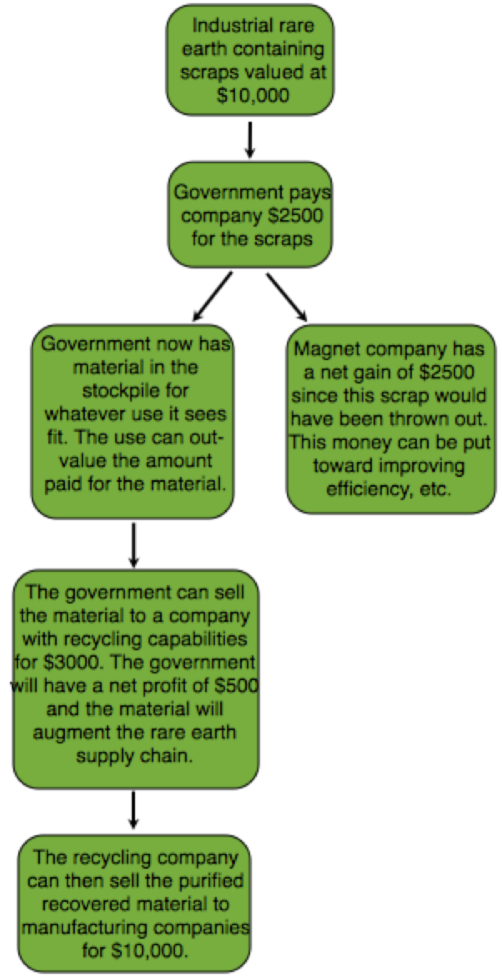Overview
Many electronic devices, such as cell phones, contain very small amounts of strategic elements. These elements are present in such small quantities that they cannot be recycled in an economically viable manner with current technology. Consequently, they are simply discarded under the status quo, wasting many resources that could be potentially be reused in the future. What Mission 2016 proposes is to implement a stockpile of devices containing strategic elements until they can be viably recycled.
A stockpile is an accumulation of some desired material created to ensure future supply. For individual countries, this is often an excellent technique because it allows the country to ensure their own private supply. However, taking trade and global distribution into account, stockpiling can bring on many undesirable economic effects. While stockpiles of the raw, pure strategic metal resources owned by individual countries may not be a good idea, as they would exist at the expense of equitable global access to these materials, stockpiles of already manufactured products containing these metals would be very beneficial.
Each government interested in a supply of strategic metals can begin a stockpile of manufactured, strategic-metal-containing products. This stockpile will accumulate through the donation of used electronics, cars, and other strategic-metal-containing products from individuals and companies. To encourage individuals to contribute to this stockpile, the program can follow the model of "cash-for-clunkers." The governments can offer incentives such as tax breaks to contributors. Once a stockpile is started, the governments can sell the material to a company with recycling capabilities domestically or internationally.
Implementation
The stockpile program will be based on the donation of strategic-metal-containing products from individuals and companies to their respective governments. To encourage the donation of these scraps to the stockpile, each government will pay the contributors a percentage of the value of the scraps. 
The chart on the left describes a method in which this stockpile program can be implemented. The numbers utilized in the chart are hypothetical, designed to illustrate an example of the implementation of this process, and not necessarily reflect actual percentages or relative prices. This must be left to governments to decide upon, to reflect their individual needs.
If the government chooses to sell the scrap to a domestic recycling company, the rare earth material will be usable once more for that country. If the scrap is sold internationally, the global supply chain will benefit and the government selling the material will benefit financially from the sale.
This model can be used for other products containing recyclable rare earth metals, platinum group elements, and other strategic metals. The prices and percentages would have to be adjusted based on the proportion of salvageable material and based on true financial modeling.
Costs
The main costs for the implementation for a stockpile will come from locating a place for storage and the initial cash to lay out for the compensation of donations. This will vary based on how much land costs in different countries and how much material is initially donated.
Case Study
20-30% of rare earth metals used in magnet production are scrapped. 21,000-27,000 tons of rare earths are required for global magnet use in 2008 (Schuler, Buchert, Liu, Dittrich & Merz, 2011). This means that about 5250-11570 tons of rare earths are scrapped each year just from magnet production. Recent studies have shown that up to 96% of the rare earths in the magnetic scraps can be recovered, depending on the type of magnet (Uda, 2002). This means that it is possible that about 5000 to 11000 tons can be salvaged yearly. (Schuler, Buchert, Liu, Dittrich & Merz, 2011).
Timeline
2013: Governments begin finding stockpile locations, legislation is proposed
2015: Legislation is completely passed
2016: Legislation is enacted, administrative details are finalized
2017: Stockpiling program begins, and governments ensure this information becomes well known through public awareness techniques. The program runs until technology is capable of economically viable recycling
Intended outcomes
Individual countries will have the ability to augment their strategic metal supply through stockpiles. Governments will be able to profit from the donated scraps and used goods. Overall supply will be increased as the stockpiled material will be prime for recycling. The recycling processes are still being worked out to determine efficiency. (See recycling page for more detail).
China plans strategic reserves for rare metals. (2010, 11 03). Retrieved from http://english.peopledaily.com.cn/90001/90778/90860/7186937.html
Clark, L. (2012, 07 05). China has been stockpiling rare earth minerals. Retrieved from http://www.wired.co.uk/news/archive/2012-07/05/china-stockpiles-rare-earth
Schuler, D., Buchert, M., Liu, R., Dittrich, S., & Merz, C. (2011). Study on rare earths and their recycling . Retrieved from http://reinhardbuetikofer.eu/wp-content/uploads/2011/01/Rare-earths-study_Oeko-Institut_Jan-2011.pdf
Uya, T. (2002). Recovery of Rare Earths from Magnetic Sludge by FeCl2 Informally published manuscript, Retrieved from http://www.jim.or.jp/journal/e/pdf3/43/01/55.pdf

